Teachers
Teach Through Games
MHS enables players to build important science knowledge and competencies in ways that fit the Next Generation Science Standards.
Focusing on water in socio-ecological systems and scientific argumentation, this game challenges players to successfully settle a newly discovered Earth-like planet. Players help their settlements thrive by implementing real-world skills and concepts to solve problems and achieve goals.
Students Thinking like Scientists
In MHS, the student becomes the scientist. Players use real-world skills to collect, analyze...
In MHS, the student becomes the scientist. Players use real-world skills to collect, analyze and draw conclusions from evidence in order to achieve goals and solve problems that arise.
Everything the player does has an impact on the environment around them. Students can instantly see the results of their decisions and actions during gameplay.
Games are designed so that players are constantly failing and learning from their failure. MHS is designed to take advantage of strategies such as feedback and visual results used in games to teach students about water systems and argumentation.
Standards Met
Next Generation Science Standards and Missouri Learning Standards: Earth and Space Science 6-8.ESS2.C.1 Design...
Next Generation Science Standards and Missouri Learning Standards:
Earth and Space Science
6-8.ESS2.C.1 Design and develop a model to describe the cycling of water through Earth’s systems driven by energy from the sun and the force of gravity.
6-8.ESS3.C.2 Apply scientific principles to design a method for monitoring and minimizing a human impact on the environment.
6-8.ESS3.A Construct a scientific explanation based on evidence for how the uneven distributions of Earth’s mineral, energy, and groundwater resources are the result of past and current geoscience processes and human activity.
6-8.ESS3.C.1 Analyze data to define the relationship for how increases in human population and per-capita consumption of natural resources impact Earth’s systems.
[Engineering, Technology, and Application of Science]
6-8.ETS1.A Define the criteria and constraints of a design problem with sufficient precision to ensure a successful solution, taking into account relevant scientific principles and potential impacts on people and the natural environment that may limit possible solutions.
Improving Classroom Performance
Our desired outcomes from the use of Mission HydroSci in the classroom are to:...
Our desired outcomes from the use of Mission HydroSci in the classroom are to:
- Increase student interest in technology, science and water systems
- Improve student argumentation competencies
- Meet Next Generation Science Standards (NGSS)
- Achieve Earth Science Water Systems Learning Objectives
Live Teacher Dashboard with Learning Analytics
The MHS live teacher dashboard displays analytics related to students’ learning progress as they...
The MHS live teacher dashboard displays analytics related to students’ learning progress as they complete various stages of the game.
While teachers typically monitor student work by walking around the classroom and observing physical behavior, the MHS Gaming Analytics system enables targeted and automated views of player engagement and success.
Using these analytics, even teachers who are unfamiliar with game based learning can easily make informed decisions on how to engage with students as they play.
Tech Requirements
The current version of MHS will only play on Mac and Windows computers. Minimum...
The current version of MHS will only play on Mac and Windows computers.
Minimum requirements for computers are to have 4 Gbytes of RAM but at least 8 is highly desired.
Computers must also have internet access in order to enable the teacher dashboard.
Play Setup
In the Classroom – This is ideal for classrooms equipped with one-to-one computers or laptops (one machine per student).
At Home – Students can play on a home computer. This is a great option for Distance and Flipped Classrooms.
In the Computer Lab – The class can visit the computer lab or classroom to use the machines there for gameplay.
Getting Started
In MHS, the student becomes the scientist. Players use real-world skills to collect,...
MHS has a scheduled field test that will begin in March 2018.
A second field test is being planned for either Fall 2018, or Spring 2019.
If you are interested in having your classes participate in any of the field testing please contact Jim Laffey at LaffeyJ@missouri.edu
Game-Based Learning
Our aim is to support and encourage student learning of important science knowledge and competencies in an engaging and fun way.
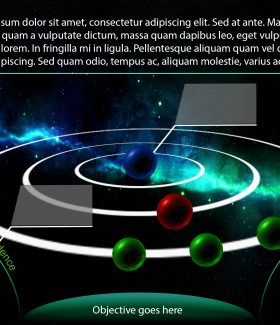
Unit 1
Intro to Argumentation
Scientific argumentation is the process of evidenced-based reasoning: using data and reasoning to arbitrate between competing claims. By monitoring the cycling of water in the terrain simulator and gathering data from the in-game sensors, students build a body of evidence to make and defend scientific claims. This is the crux of Mission HydroSci – teaching students how to link their understandings of core science ideas with scientific practices, allowing them to make well-reasoned claims and defend those claims. This unit also provides a tutorial to the gameplay.
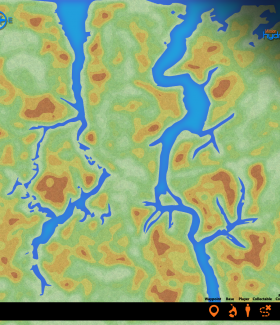
Unit 2
Topography
As a preface to the Water Systems, Unit 2 is a brief lesson on how Topography defines Watersheds. The crux of this Unit has students determine the size of a watershed by measuring water flow of two waterfalls.
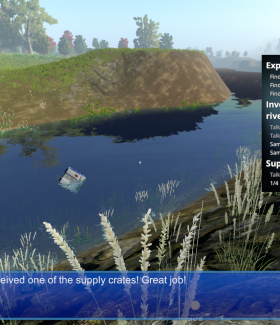
Unit 3
Surface Water
In this Unit players are introduced to surface water topics, such as what determines the direction of flow, and how pollutants spread through a river system.
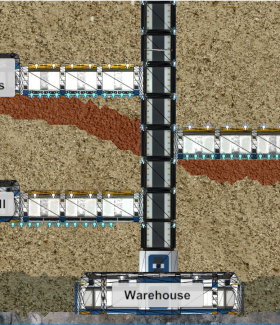
Unit 4
Underground Water
In the Desert Unit, players need to understand how water infiltrates through soil layers in order to access underground water reserves.
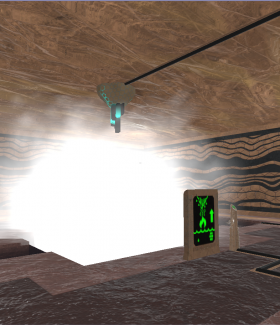
Unit 5
Atmospheric Water
This Unit places students on a tropical island with unlimited access to sea water. Players need to understand the processes of how water evaporates and condenses in order to complete this mission.

Unit 6
Human Impacts
In the final Unit, players will complete their mission and experience the narrative resolution. Although this unit is more summative of previously covered topics, it does center around measuring and controlling human impacts on a natural system.
Mission Testimonials
"My classes tried out Mission HydroSci for a week in the fall. I used the video game as I would any other resource. I prepped students with info; so they would have some of the prior knowledge needed for the game, I paused periodically to make sure they remembered the purpose of each day, and I concluded by reviewing over concepts that they should have been learning. My students enjoyed the game and the puzzles within the game. I found that I had new student leaders emerge during game play. Many of my gamers were able to take on a leadership role, and it was awesome! It was definitely worth our time to play this educational game."
